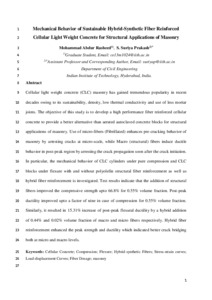Rasheed, Mohammad Abdur and S, Suriya Prakash
(2015)
Mechanical behavior of sustainable hybrid-synthetic fiber reinforced cellular light weight concrete for structural applications of masonry.
Construction and Building Materials, 98.
pp. 631-640.
ISSN 0950-0618
![[img]](http://raiithold.iith.ac.in/1912/1.hassmallThumbnailVersion/Construction%20and%20Building%20Materials_98_631-640_2015.pdf)  Preview |
|
Text
Construction and Building Materials_98_631-640_2015.pdf
- Accepted Version
Download (1MB)
| Preview
|
Abstract
Cellular light weight concrete (CLC) masonry has gained tremendous popularity in recent decades owing to its sustainability, density, low thermal conductivity and use of less mortar joints. The objective of this study is to develop a high performance fiber reinforced cellular concrete to provide a better alternative than aerated autoclaved concrete blocks for structural applications of masonry. Use of micro-fibers (fibrillated) enhances pre-cracking behavior of masonry by arresting cracks at micro-scale, while macro (structural) fibers induce ductile behavior in post-peak region by arresting the crack propagation soon after the crack initiation. In particular, the mechanical behavior of CLC cylinders under pure compression and CLC blocks under flexure with and without polyolefin structural fiber reinforcement as well as hybrid fiber reinforcement is investigated. Test results indicate that the addition of structural fibers improved the compressive strength up to 66.8% for 0.55% volume fraction. Post-peak ductility improved up to a factor of nine in case of compression for 0.55% volume fraction. Similarly, it resulted in 15.31% increase of post-peak flexural ductility by a hybrid addition of 0.44% and 0.02% volume fraction of macro and micro fibers respectively. Hybrid fiber reinforcement enhanced the peak strength and ductility which indicated better crack bridging both at micro and macro levels.
Actions (login required)
 |
View Item |


 Altmetric
Altmetric Altmetric
Altmetric